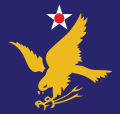World War II
The squadron was first activated at Salt Lake City Army Air Base, Utah on 1 October 1942 as one of the four original squadrons of the 351st Bombardment Group. Its cadre moved the same day to Gowen Field, Idaho, where it could begin manning as a heavy bomber unit. The squadron moved to Geiger Field, Washington in November and began training for combat with the Boeing B-17 Flying Fortress. [1] [3] The squadron completed its training in April 1943 and departed for the European Theater of Operations. [3] [4] The air echelon began ferrying its B-17s about 1 April, while the ground echelon left for the New York Port of Embarkation on 12 April. [1]
The ground and air echelons had arrived at the unit's combat station, RAF Polebrook, England by 12 May 1943, and the squadron flew its first mission on 14 May. The squadron primarily flew strategic bombing missions against Germany. It struck targets including ball bearing factories at Schweinfurt; bridges near Köln; oil refineries at Hamburg; communications targets near Mayen; marshalling yards at Koblenz and industrial targets at Berlin, Hannover, and Mannheim. Other targets in France, Belgium, the Netherlands and Norway included airfields, harbor installations, and submarine pens. [4]
On 9 October 1943, the squadron attacked the Arado Flugzeugwerke aircraft factory Anklam, Germany. Despite heavy flak and attacks by enemy fighters, accurate bombing inflicted heavy damage on the target. The squadron was awarded its first Distinguished Unit Citation (DUC) for this action. On 11 January 1944, as Operation Pointblank continued, it attacked the heavily defended Focke-Wulf Fw 190 production facility at Oschersleben, without fighter escort and in the face of the strongest fighter opposition encountered for five months, for which it earned a second DUC. It continued attacks on German aircraft production during Big Week, the concentrated attack by VIII Bomber Command against the German aircraft industry in late February. [4] [5]
The squadron was occasionally withdrawn from strategic missions to provide air support and interdiction. In the buildup to Operation Overlord, the invasion at Normandy, the squadron participated in Operation Crossbow, attacking V-1 flying bomb and V-2 rocket launch sites. In June 1944, it provided support for the landings, and the following month supported Operation Cobra, the breakout at Saint Lo. In September, it supported Operation Market Garden, an unsuccessful airborne attack attempting to obtain a bridgehead across the Rhine at Arnhem. From December 1944 through January 1945, it attacked front line positions during the Battle of the Bulge. In March 1945, it flew missions to support Operation Varsity, the airborne assault across the Rhine in Germany. [4]
Following V-E Day, the squadron left England, with the first plane being flown back by its crew departing on 21 May 1945. The ground echelon sailed on the RMS Queen Elizabeth in June 1945. It briefly assembled at Sioux Falls Army Air Field, South Dakota, and was inactivated there on 28 August 1945. [3] [1]
Air Force reserve
The squadron was activated again in October 1947 in the reserves and trained at Fairfax Field under the supervision of Air Defense Command (ADC)'s 4101st AAF Base Unit (later the 2472d Air Force Reserve Training Center), although its headquarters, the 351st Bombardment Group, was stationed at Scott Field, Illinois. [6] [4] The following year Continental Air Command assumed responsibility for managing reserve units from ADC. [7] [3]
Although nominally a very heavy bomber unit, it is not clear whether or not the squadron was fully staffed or equipped. [8] President Truman’s reduced 1949 defense budget required reductions in the number of units in the Air Force, [9] and the 511th was inactivated [3] and most of its personnel transferred to elements of the 442d Troop Carrier Wing at Fairfax. [10]


